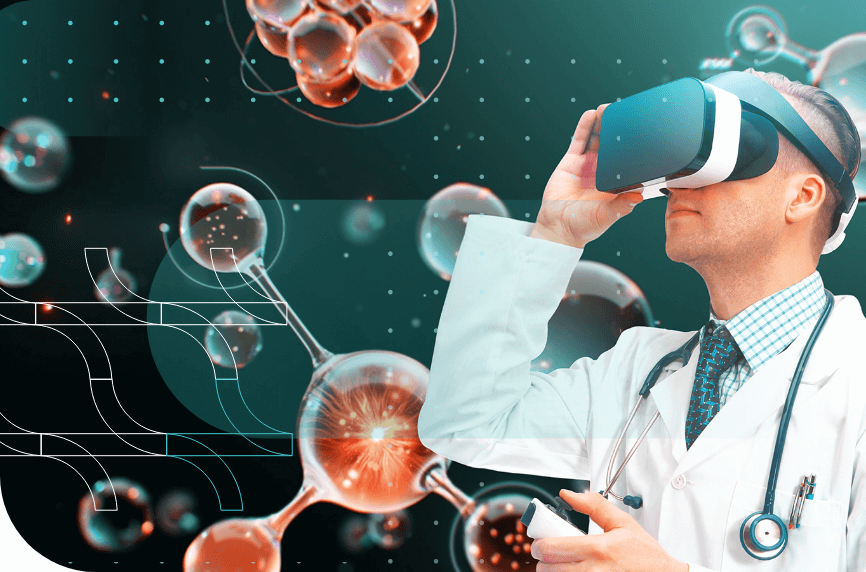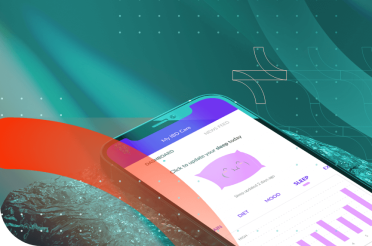Having doctors and nurses is an integral part of society. The world we live in is constantly a witness to new technology. One example of these technological advances is virtual reality (VR).
While it has proven to have many applications in a multitude of different fields and practices, it has had a particular significance for the healthcare industry. 68% of experts believe virtual and augmented reality will have a huge part to play in medical education and clinical skills (1).
Simulation has always been an essential training tool in the way we teach students, especially in medical educational institutions. But it is a fact that using body dummies and other technology can be quite costly.
With the help of VR, however, simulations can be far more cost-efficient and repeatable. Using virtual reality could greatly improve the learning experience for medical students.
What is virtual reality?
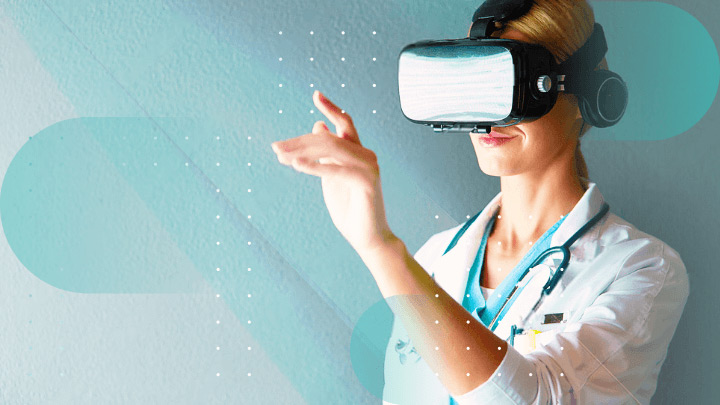
Virtual reality is the use of immersive technologies to create a simulated environment. Books and movies, even songs, can be quite immersive and a person can get lost in them, but an actual virtual world can help people experience things more directly.
This process is accomplished through the use of a head-mounted display (HMD), also called a VR headset. Through such virtual reality devices, the user is placed in an environment with which they can interact and experience it more fully.

Don’t miss out on the growing role of VR in Medical Education.
See how VR technology can transform your medical training programs by booking a consultation with one of our strategy experts today.

This would allow a student a more practical and experiential learning experience. This experience on demand is what truly separates VR simulations from traditional training.
There are, of course, various forms of technological advances that VR particularly is responsible for.
360 video
360 video is a way to film a certain setting at a 360 degree angle. A special camera that can film in all directions is used to take in the surroundings and VR equipment is there to access the film.
The headset the user would have makes them feel like they are in the middle of the shot and they can see everything around as they turn their head, for example.
Such technology can be used in the healthcare sector and especially in medical institutions during physical therapy for pain management, taking the focus off the task itself and allowing patients to dive into a recorded world. The experience, however, is still mainly passive as the user cannot interact with the environment, only observe.
Screen-based learning
In the past several decades, the term “virtual reality” was widely adopted to mean screen-based technologies, including online training. It has come to mean, however, only an experience allowing students and all users to completely block out the real world through the use of a headset. The process has to recreate the sensation of presence in the world that is provided and screen-based tech can’t wholly offer that.
Interactive virtual reality
Interactive VR in medical training offers a highly immersive and dynamic learning experience. It recreates realistic virtual environments where learners can interact with virtual patients, colleagues, and relatives, similar to real-world scenarios.
For example, during ongoing training in a virtual emergency department, learners can take a patient’s history, perform examinations, make diagnoses, and provide treatment. All of this while experiencing the stress and challenges of a realistic hospital environment.
The focus of interactive VR is on decision-making, critical thinking, communication skills, and clinical reasoning, simulating human interactions and replicating real-world scenarios. After completing scenarios, learners can receive virtual debriefing and immediate feedback on their performance, helping them analyze their skills and learn from the experience.
Feedback can cover technical and non-technical skills, facilitating effective learning and peer collaboration for further discussion and learning.Companies like Oxford Medical Simulation are already delivering such interactive VR platforms globally, covering various medical fields and expanding content across disciplines.
Artificial intelligence in VR healthcare
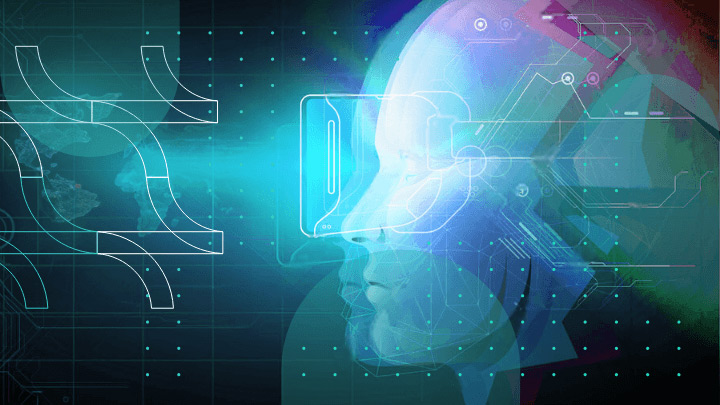
Artificial intelligence (AI) and virtual reality (VR) technologies are increasingly being combined to enhance medical training and education. When AI is integrated into VR platforms, it can provide advanced capabilities and intelligent features that further enhance the effectiveness and realism of medical training simulations.
There are a couple of ways this can be accomplished:
- Intelligent virtual patients. Virtual patients, powered by AI, can exhibit realistic behavior, responses, and physiological parameters. They can simulate a wide range of medical conditions, allowing trainees to practice diagnosis, treatment, and patient management. AI algorithms can enable virtual patients to respond dynamically to trainee actions, providing realistic scenarios and enhancing the learning experience.
- Adaptive learning. AI algorithms can analyze trainee performance data in VR simulations and adapt the training experience accordingly. By monitoring trainee actions, AI can identify areas of strength and weakness and dynamically adjust the difficulty level or content of the simulation. This adaptive learning approach ensures personalized training and maximizes learning outcomes.
- Natural language processing. AI-powered natural language processing enables trainees to interact with virtual patients and receive realistic responses. Trainees can ask questions, provide instructions, or engage in conversations, and the AI system can analyze and respond appropriately. This enhances communication skills and the ability to gather patient information.
- Intelligent feedback and assessment. AI algorithms can provide real-time feedback and assessment during VR training sessions. They can analyze trainee actions, accuracy, and decision-making, providing immediate feedback on performance. AI can also generate detailed performance reports, identifying areas for improvement and providing personalized recommendations.
- Data analytics and insights. Artificial intelligence can analyze the vast amount of data generated during VR training sessions, extracting valuable insights for trainee assessment and curriculum improvement. By analyzing trainee performance data, AI can identify patterns, trends, and areas where additional training or support may be required.
- Virtual surgical assistance. AI algorithms can provide real-time guidance and assistance during virtual surgical procedures. By analyzing surgical actions, AI can detect errors, provide recommendations for optimal techniques, and highlight potential risks. This can help trainees refine their surgical skills and enhance patient safety.
Intelligent tutoring. AI-powered intelligent tutoring systems can guide trainees through VR simulations, providing step-by-step instructions, explanations, and demonstrations. These systems can adapt to trainee needs, track progress, and provide personalized guidance and support throughout the training process.
Virtual reality in the mental health field

VR technology has shown great potential in the field of mental health.
Exposure therapy
VR can be used to create virtual environments that simulate real-world scenarios, allowing individuals to safely confront and overcome their fears and phobias. It has proven effective in treating anxiety disorders, post-traumatic stress disorder (PTSD), and specific phobias.
The way this is accomplished is by allowing the person to confront their fears and anxieties in a safe and controlled environment where they can practice proven techniques of coping and managing their stress.

Capitalize on the numerous benefits of VR technology and Capplications.
Discover the true potential of VR in healthcare a consultation with one of our technology experts at BGO Software.
The process has proven to be quite effective in such cases and is continued to be studied by many different institutions. Virtual reality equipment has also been used for research to better understand these disorders and similar mental health issues because it allows for the specific study of triggers and behavior.
Stress and anxiety reduction
VR environments can be designed to promote relaxation, mindfulness, and stress reduction. Immersive experiences such as calming virtual nature scenes or guided meditation can help individuals manage stress, anxiety, and improve overall well-being.
Patients suffering from chronic pain are also treated through this practice by creating an environment they can redirect their focus to, forgetting about the pain and learning to better cope with it.
Skills training and rehabilitation
VR can be used to provide simulated training and rehabilitation experiences. For example, it can be used for social skills training in individuals with autism spectrum disorder, or for cognitive and motor rehabilitation in stroke patients. VR allows for controlled and repeatable training sessions in a safe and engaging environment.
One of the hardest parts of healthcare treatment is handling the rehabilitation of motor skill disorders and virtual reality can be of great assistance to it.
For patients that have undergone neurosurgery or nerve treatment, for instance, it is far more difficult to relearn many different movement patterns and exercises and VR can visually show them how their body is supposed to move, allowing for faster and smoother recovery.
Virtual support and therapy
VR can facilitate remote therapy sessions, allowing individuals to access mental health support from the comfort of their own homes. This is particularly beneficial for individuals who may have limited access to in-person therapy or those who prefer the anonymity and convenience of virtual sessions.
The technology can allow patients to also break their sedentary lifestyle for those who find it difficult to leave their homes, allowing them to experience a safe environment, simulating real-world situations.
Empathy and perspective-building
These are crucial aspects of understanding and addressing mental health issues. VR technology provides a powerful tool for creating immersive experiences that can foster empathy and promote awareness.
By providing a safe and controlled environment, VR experiences enable individuals to explore perspectives that are different from their own. This can be particularly valuable in fostering empathy towards marginalized groups or individuals with mental health challenges. Through the simulation, individuals can develop a deeper sense of empathy, compassion, and understanding, leading to increased support and reduced discrimination.
The immersive nature of VR allows individuals to emotionally connect with the simulated experiences in a way that traditional media or descriptions cannot fully achieve. They can explore different environments, interact with virtual characters, and engage in scenarios that replicate real-life situations. This immersive exposure helps break down stereotypes, reduces stigma, and increases understanding of mental health issues.
Moreover, VR-based empathy training can be beneficial for healthcare professionals, caregivers, and family members. By experiencing the challenges faced by individuals with mental health issues, they can gain a better understanding of their needs, enhance communication skills, and provide more effective support and care.
Benefits of VR for medical training
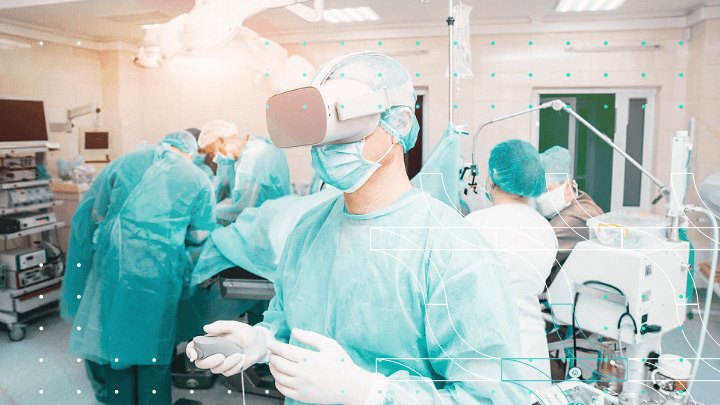
Integrating VR technologies and equipment in medical training can completely replace rote learning in the educational process and make better future clinicians. Listed below are some key benefits of using VR in medical training.
Hands-on practice
VR provides highly realistic and immersive simulations of medical scenarios, medical procedures, and environments. Trainees can experience lifelike patient interactions and surgical procedures, enhancing their understanding and preparedness for real-life situations.
A virtual reality headset can allow for hands-on practice, enabling trainees to actively engage in complex procedures and clinical training. They can manipulate virtual instruments, perform surgeries, practice diagnostic techniques, and interact with a virtual human body.
This interactive learning approach enhances skill acquisition and retention. Surgical training, for example, can be carried out with a far greater consideration for patient safety given that medical students can practice operations on a realistic human anatomy.
Safe learning environment
VR eliminates the risks associated with training on real patients by providing a safe and controlled learning environment. Trainees can make mistakes, learn from them, and repeat procedures without any harm to patients. This promotes confidence, competence, and proficiency development.
VR platforms can adapt to individual trainee needs, providing personalized training experiences. Trainees can progress at their own pace, receive immediate feedback on their performance, and focus on areas that require improvement. This personalized approach enhances learning outcomes and efficiency.
The greatest part of augmented reality training in medicine is that students learn with their actual body, practicing specific movements and learning rapidly developing accurate motor skills. These movements can then be used in actual operations when they are ready.
Access to rare or complex cases
VR enables trainees to experience and learn from rare or complex medical cases that they may not encounter frequently in real-world settings. Virtual simulations can replicate challenging scenarios, allowing trainees to gain exposure and develop expertise in managing such cases.
This way, students can balance skills because they would have access to a wider variety of cases and get to work with many different scenarios that would not be ready and available in a real-world setting.
Trainees can also repeat VR simulations as many times as needed to reinforce their knowledge and skills. They can review their performance, identify areas for improvement, and practice until they achieve proficiency.
This repetitive training promotes mastery and competency development. Due to ethical principles, for example, doctors cannot always see what went wrong in an operation, but thanks to VR they can repeat it over and over until they learn to master a technique.
Collaboration and remote learning
VR facilitates collaborative training experiences, allowing multiple trainees to interact and work together in virtual scenarios. Healthcare providers from different locations can participate in team-based simulations, enhancing communication, coordination, and teamwork skills through peer learning practices. Being able to share information is a key part of why medicine has evolved rapidly in the past.
Another vital aspect of VR is that it enables remote learning and training, breaking geographical barriers and further promoting the sharing of information. Trainees and medical professionals can access VR modules and simulations from anywhere, reducing the need for physical presence in specific training centers.
This is particularly beneficial for remote areas or regions with limited access to specialized training resources. Since specific medical knowledge can be required everywhere around the globe, it is amazing that people from anywhere can practice in a safe virtual environment.
Cost and resource efficiency
Cost and resource efficiency in VR-based medical training offers several advantages. It reduces training costs by eliminating the need for physical resources like cadavers and disposable equipment.
The technology also allows for repeated use of VR simulations instead of wasting resources. It optimizes resource utilization by enabling multiple trainees to participate simultaneously in a virtual environment. Time efficiency is achieved as trainees can access training modules remotely, saving travel time and allowing for flexible scheduling.
VR training platforms are also scalable and flexible, accommodating different training needs and eliminating constraints of physical space and equipment. Additionally, these platforms provide performance analytics and feedback mechanisms, facilitating personalized learning and reducing the need for additional resources.
Overall, VR in medical training offers a unique and impactful learning experience that enhances skill acquisition, promotes patient safety, and prepares healthcare professionals for real-world challenges. It has the potential to revolutionize medical education and improve the quality of care and patient satisfaction.
Virtual and augmented reality can be a great asset to the healthcare industry and to the education of future medical professionals. The software required to develop such a practice with VR technology can be quite daunting when you don’t know where to start from.

Whether you’re a startup, a Fortune 100 company or a government organisation, our team can deliver a solution that works for you.
BGO Software
It can be confusing to decide whether to use ready-made equipment and software or a custom-developed system. In such a case what a healthcare provider or an educational institution needs is a trusted partner with years of experience in the field of medical software development like BGO Software.
Sources:
Training simulations are expected to be a major application of immersive technologies in the healthcare sector within the next two years according to 68 percent of XR industry experts who responded to the 2020 survey. (1)

